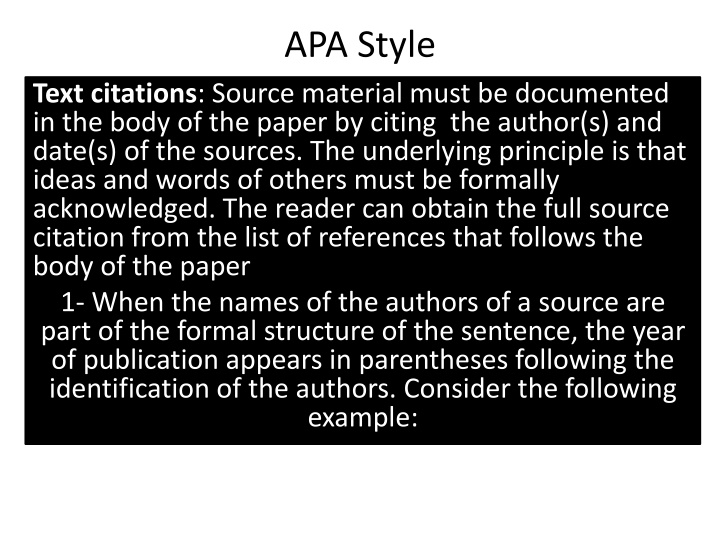
APA Style Citations and Source Documentation Guidelines
Learn how to properly document and cite sources in APA style text citations. Understand the importance of acknowledging the ideas and words of others through formal citations. Explore examples and guidelines for citing authors and dates within the text to ensure proper referencing. Discover the underlying principles of source documentation and references for academic writing.
Download Presentation

Please find below an Image/Link to download the presentation.
The content on the website is provided AS IS for your information and personal use only. It may not be sold, licensed, or shared on other websites without obtaining consent from the author. If you encounter any issues during the download, it is possible that the publisher has removed the file from their server.
You are allowed to download the files provided on this website for personal or commercial use, subject to the condition that they are used lawfully. All files are the property of their respective owners.
The content on the website is provided AS IS for your information and personal use only. It may not be sold, licensed, or shared on other websites without obtaining consent from the author.
E N D
Presentation Transcript
APA Style Text citations: Source material must be documented in the body of the paper by citing the author(s) and date(s) of the sources. The underlying principle is that ideas and words of others must be formally acknowledged. The reader can obtain the full source citation from the list of references that follows the body of the paper 1- When the names of the authors of a source are part of the formal structure of the sentence, the year of publication appears in parentheses following the identification of the authors. Consider the following example:
1*Mateo (1995) stated that the old concept said about irony saying one thing and meaning another is no longer accurate portrayal of the complex techniques used by writers to create irony. This is confirmed by Simpson (2011) who stated that irony has a frequent and common definition: saying what is contrary to what is meant. Irony is such a highly rhetorical and elusive tool that it is difficult to define in terms of its interpretation, let alone style and language (Chakhachiro, 2011). Mateo, M. (1995). The Translation of Irony, Meta, XL. 1. Simpson, Paul. (2011). That s not ironic, that s just stupid: Towards an eclectic account of the discourse of irony. In: Marta Dynel (Ed.), The Pragmatics of Humour across Discourse Domains. Amsterdam, Philadelphia: John Benjamins Publishing Company, 33-50.
2*Recently, different questions about the impact of tests are being asked. Work from the field of World Englishes has called into question the validity of tests in light of the use of English as an international language specifically the extent to which current tests and test design practices represent the way English is now used in the global context (Widdowson, 2012) Widdowson, H. G. (2012). ELF and the inconvenience of established concepts. Journal of English as a Lingua Franca, 1(1), 5 26. doi: 10.1515/jelf- 2012-0002
3-*Alternatively, important considerations about testing within the teaching English as an international language (TEIL) context have been raised, in particular that recent debates about assessment of English as an international language have revolved around two important questions: Whose norms should we apply? How do we define proficiency in the English language? (Canagarajah, 2006, p.229).
Canagarajah, A. S. (2006). Changing communicative needs,revised assessment objectives: Testing English as an International Language. Language Assessment Quarterly, 3(3), 229 42.doi:10.1207/s15434311laq0303_1
*Wirth and Mitchell (1994) found that although there was a reduction in insulin dosage over a period of two weeks in the treatment condition compared to the control condition, the difference was not statistically significant. [Note: and is used when multiple authors are identified as part of the formal structure of the sentence Compare this to the example in the following
2-When the authors of a source are not partof the formal structure of the sentence, both the authors and years of publication appear in parentheses, separated by Commas and between two references or more to use semicolons. Consider the following example and example no 3: *Reviews of research on religion and health have concluded that at least some types of religious behaviors are related to higher levels of physical and mental health (Gartner , Larson,& Allen, 1991; Koenig,1990; Levin & V anderpool,1991; Maton & Pargament, 1987;Paloma &Pendleton,1991;Payne,Bergin, Bielema, & Jenkins,1991). [Note: &is used when multiple authors are identified in parenthetical material. Note also that when several sources are cited parenthetically ,they are ordered alphabetically by first authors surnames.]
3-When a source that has two authors is cited, both authors are included every time the source is cited. 4-When a source that has three, four ,or five authors is cited, all authors are included the first time the source is cited. When that source is cited again,the first author's surname and "et al." are used. Consider the following example: *Reviews of research on religion and health have concluded that at least some types of religious behaviors are related to higher levels of physical and mental health (Payne,Bergin, Bielema, & Jenkins,1991). Payne et al. (1991) showed that ....
